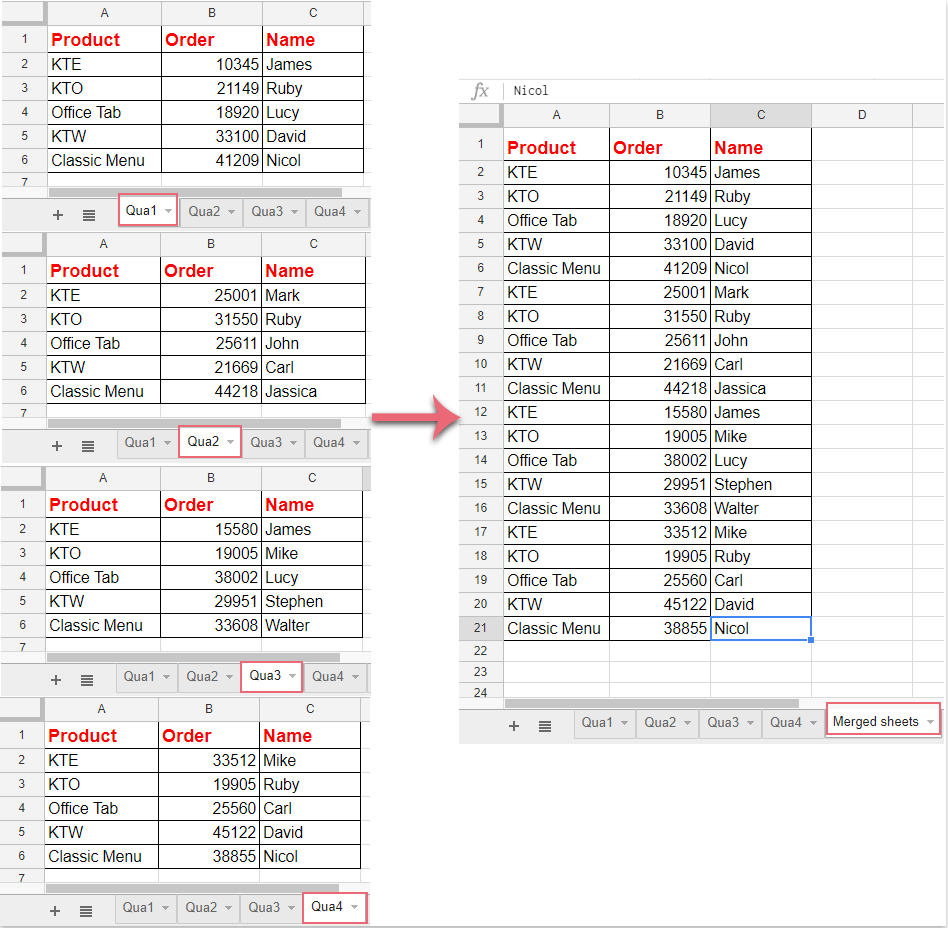Effortlessly Merge Excel Sheets: Quick Guide

Merging multiple Excel sheets can transform a potentially tedious task into a streamlined process. Whether you're compiling financial data, customer records, or any other dataset, understanding how to effectively combine information from different Excel sheets is crucial for efficient data management. In this quick guide, we will delve into the effortless Excel sheet merging techniques, ensuring you can handle your spreadsheets with ease and precision.
Why Merge Excel Sheets?

Before diving into the methods, it's worth understanding why merging Excel sheets is beneficial:
- Consolidation of Data: Bringing all your relevant data into one place.
- Consistency: Ensuring uniformity across datasets for analysis.
- Efficiency: Saving time by not having to switch between multiple files.
- Accuracy: Reducing errors from manual data entry.
💡 Note: Merging Excel sheets can streamline workflows, but always ensure you have backups of your original data before proceeding.
Methods to Merge Excel Sheets

Using Excel’s Built-In Consolidate Feature

Excel’s Consolidate feature is ideal for merging data that shares the same structure:
- Select the Destination: Choose the worksheet where you want the merged data.
- Go to Data Tab: Click on the Data tab in the Ribbon, then select “Consolidate”.
- Choose Function: Decide how you want to combine the data (e.g., Sum, Count, Average).
- Select Ranges: Add each Excel range or sheet you want to consolidate.
- Use Top Row/Left Column: Select this option if your data has headers or labels.
- Create Links: If you want dynamic updates, check this box.
- Click OK: Let Excel merge the sheets automatically.
Your data is now consolidated in the destination sheet, ready for further analysis or manipulation.
Power Query for Advanced Merging

For those dealing with more complex datasets or needing regular updates, Power Query in Excel 2013 and later versions provides advanced functionality:
- Activate Power Query: Go to the Data tab, then “Get Data” -> “From File” -> “From Workbook”.
- Select Excel Files: Navigate to and select the Excel files you want to merge.
- Transform Data: Use the Power Query Editor to preview and clean data, then load it into Excel.
- Merge Queries: Use the “Merge Queries” option to join data based on common columns.
- Adjust Settings: Configure join types (left, inner, etc.) and key columns.
- Load Data: Once configured, load the merged data back into Excel.
Using VBA for Automated Merging

For repetitive tasks or when dealing with many files, VBA scripts can automate the merge process:
Sub MergeExcelFiles() ‘Declare variables Dim wb As Workbook Dim ws As Worksheet Dim fileName As Variant Dim folderPath As String'Set folder path folderPath = "C:\Your\Folder\Path\Here\" 'Open each workbook in the folder fileName = Dir(folderPath & "*.xlsx") Do While fileName <> "" Set wb = Workbooks.Open(folderPath & fileName) For Each ws In wb.Worksheets ws.Copy After:=ThisWorkbook.Sheets(ThisWorkbook.Sheets.Count) Next ws wb.Close SaveChanges:=False fileName = Dir Loop
End Sub
This script will loop through all Excel files in the specified folder and copy each worksheet into the workbook where the macro runs.
💡 Note: Always customize paths and adjust VBA code according to your specific needs.
Advanced Tips for Merging Excel Sheets

- Macro Recording: If you’re not versed in VBA, record your merge process as a macro, then refine it.
- Data Consistency: Ensure data formats and structures match across all sheets before merging.
- Error Handling: Include error handling in VBA scripts to manage potential issues like missing files or errors during merging.
- Dynamic Ranges: Use dynamic named ranges or tables to make your merging process more flexible and less prone to errors.
By implementing these methods, you can manage data more effectively, ensuring your Excel sheets are organized and optimized for further analysis. Now, let's address some common questions and wrap up our guide.
What is the simplest way to merge Excel sheets?

+
The simplest way is often using Excel’s Consolidate feature, especially if your sheets have a consistent structure and you’re looking for basic data aggregation like sums or averages.
Can I automate Excel sheet merging?

+
Yes, using VBA (Visual Basic for Applications) scripting allows you to automate repetitive merging tasks, especially useful when dealing with multiple files or recurring data updates.
What are the benefits of using Power Query for merging?

+
Power Query offers advanced data manipulation capabilities, the ability to handle complex merges, and provides an interface to refresh data automatically, making it perfect for dynamic and intricate data merging scenarios.